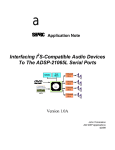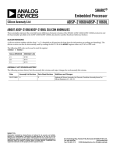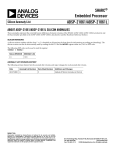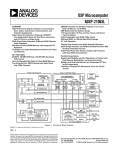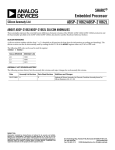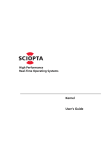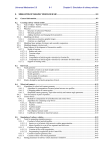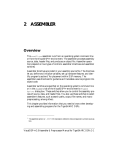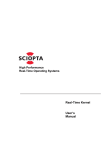Download ADSP-2106x SHARC User's Manual
Transcript
ADSP-2106x SHARC User’s Manual Second Edition (7/96) SUPER HARVARD ARCHITECTURE COMPUTER ADSP-2106x SHARC User’s Manual 1996 Analog Devices, Inc. ALL RIGHTS RESERVED Information furnished by Analog Devices is believed to be accurate and reliable. However, no responsibility is assumed by Analog Devices for its use; nor for any infringement of patents or other rights of third parties which may result from its use. No license is granted by implication or otherwise under the patent rights of Analog Devices. PRINTED IN U.S.A. Second Edition July 1996 Analog Devices, Inc. Computer Products Division One Technology Way P.O. Box 9106 Norwood, MA 02062-9106 (617) 329-4700 If you have comments or suggestions about this manual or find any errors in it, please contact us via email at: [email protected] For product marketing information or technical support, contact any Analog Devices sales office or authorized distributor. For applications engineering assistance, contact: DSP Applications Engineering Phone: (617) 461-3672 Massachusetts Fax: (617) 461-3010 email: [email protected] Phone: (408) 879-3037 California Phone: (404) 263-3722 Georgia Analog Devices maintains a DSP BBS supporting V.32bis, V.42 and MNP classes 2,3,4 error correction, and V.42bis and MNP class 5 data compression which can be reached at: (617) 461-4258 8 data bits, no parity, 1 stop bit, 300/1200/2400/9600/14400 baud All information on the BBS is also available from Analog Devices’ Internet FTP site. Login as anonymous using your email address for your password, and type (from the Unix prompt): ftp ftp.analog.com Printed on recycled paper. (or ftp 137.71.23.21 ) Contents CHAPTER 1 INTRODUCTION 1.1 OVERVIEW ..........................................................................................................1-1 1.2 ADSP-21000 FAMILY FEATURES & BENEFITS ................................................1-5 1.2.1 System-Level Enhancements ..........................................................................1-6 1.2.2 Why Floating-Point DSP? ................................................................................1-7 1.3 ADSP-2106X ARCHITECTURE ...........................................................................1-8 1.3.1 Core Processor ................................................................................................1-8 1.3.1.1 Computation Units .......................................................................................1-8 1.3.1.2 Data Register File ........................................................................................1-8 1.3.1.3 Program Sequencer & Data Address Generators .......................................1-9 1.3.1.4 Instruction Cache .......................................................................................1-10 1.3.1.5 Interrupts....................................................................................................1-10 1.3.1.6 Timer..........................................................................................................1-10 1.3.1.7 Core Processor Buses ...............................................................................1-10 1.3.1.8 Internal Data Transfers ..............................................................................1-11 1.3.1.9 Context Switching ......................................................................................1-11 1.3.1.10 Instruction Set ............................................................................................1-12 1.3.2 Dual-Ported Internal Memory .........................................................................1-12 1.3.3 External Memory & Peripherals Interface ......................................................1-13 1.3.4 Host Processor Interface ...............................................................................1-13 1.3.5 Multiprocessing ..............................................................................................1-14 1.3.6 I/O Processor .................................................................................................1-14 1.3.6.1 Serial Ports ................................................................................................1-14 1.3.6.2 Link Ports ...................................................................................................1-15 1.3.6.3 DMA Controller ..........................................................................................1-15 1.3.6.4 Booting.......................................................................................................1-16 1.4 DEVELOPMENT TOOLS ...................................................................................1-16 1.5 MESH MULTIPROCESSING .............................................................................1-18 1.6 ADDITIONAL LITERATURE ..............................................................................1-18 CHAPTER 2 2.1 2.2 2.2.1 2.2.2 2.2.3 2.3 2.4 COMPUTATION UNITS OVERVIEW ..........................................................................................................2-1 IEEE FLOATING-POINT OPERATIONS .............................................................2-2 Extended Floating-Point Precision ...................................................................2-3 Short Word Floating-Point Format ...................................................................2-3 Floating-Point Exceptions ................................................................................2-4 FIXED-POINT OPERATIONS ..............................................................................2-4 ROUNDING ..........................................................................................................2-4 iii Contents 2.5 ALU ......................................................................................................................2-5 2.5.1 ALU Operation .................................................................................................2-6 2.5.2 ALU Operating Modes .....................................................................................2-6 2.5.2.1 Saturation Mode ..........................................................................................2-7 2.5.2.2 Floating-Point Rounding Modes ..................................................................2-7 2.5.2.3 Floating-Point Rounding Boundary..............................................................2-7 2.5.3 ALU Status Flags .............................................................................................2-7 2.5.3.1 ALU Zero Flag (AZ) .....................................................................................2-8 2.5.3.2 ALU Underflow Flag (AZ, AUS) ...................................................................2-8 2.5.3.3 ALU Negative Flag (AN) ..............................................................................2-8 2.5.3.4 ALU Overflow Flag (AV, AOS, AVS) ...........................................................2-8 2.5.3.5 ALU Fixed-Point Carry Flag (AC) ................................................................2-9 2.5.3.6 ALU Sign Flag (AS) .....................................................................................2-9 2.5.3.7 ALU Invalid Flag (AI) ...................................................................................2-9 2.5.3.8 ALU Floating-Point Flag (AF) ......................................................................2-9 2.5.3.9 Compare Accumulation ....................................................................................2-9 2.5.4 ALU Instruction Summary ..............................................................................2-10 2.6 MULTIPLIER ......................................................................................................2-11 2.6.1 Multiplier Operation ........................................................................................2-11 2.6.2 Fixed-Point Results ........................................................................................2-12 2.6.2.1 MR Registers .............................................................................................2-12 2.6.3 Fixed-Point Operations ..................................................................................2-13 2.6.3.1 Clear MR Register .....................................................................................2-13 2.6.3.2 Round MR Register ...................................................................................2-14 2.6.3.3 Saturate MR Register On Overflow ...........................................................2-14 2.6.4 Floating-Point Operating Modes ....................................................................2-15 2.6.4.1 Floating-Point Rounding Modes ................................................................2-15 2.6.4.2 Floating-Point Rounding Boundary............................................................2-15 2.6.5 Multiplier Status Flags....................................................................................2-15 2.6.5.1 Multiplier Underflow Flag (MU) ..................................................................2-16 2.6.5.2 Multiplier Negative Flag (MN) ....................................................................2-17 2.6.5.3 Multiplier Overflow Flag (MV) ....................................................................2-17 2.6.5.4 Multiplier Invalid Flag (MI) .........................................................................2-17 2.6.6 Multiplier Instruction Summary.......................................................................2-18 2.7 SHIFTER ............................................................................................................2-19 2.7.1 Shifter Operation ............................................................................................2-19 2.7.2 Bit Field Deposit & Extract Instructions ..........................................................2-20 2.7.3 Shifter Status Flags........................................................................................2-24 2.7.3.1 Shifter Zero Flag (SZ) ................................................................................2-24 2.7.3.2 Shifter Overflow Flag (SV) .........................................................................2-24 2.7.3.3 Shifter Sign Flag (SS) ................................................................................2-24 2.7.4 Shifter Instruction Summary...........................................................................2-25 iv Contents 2.8 2.9 2.9.1 MULTIFUNCTION COMPUTATIONS ................................................................2-26 REGISTER FILE ................................................................................................2-27 Alternate (Secondary) Registers ....................................................................2-28 CHAPTER 3 3.1 3.1.1 3.1.2 3.1.2.1 3.2 3.2.1 3.2.2 3.2.3 3.2.4 3.3 3.4 3.4.1 3.4.2 3.5 3.5.1 3.5.1.1 3.5.1.2 3.5.1.3 3.5.2 3.5.3 3.5.3.1 3.5.3.2 3.6 3.6.1 3.6.2 3.6.3 3.6.4 3.6.5 3.6.5.1 3.6.5.2 3.6.6 3.6.7 3.6.8 3.6.9 PROGRAM SEQUENCING OVERVIEW ..........................................................................................................3-1 Instruction Cycle ..............................................................................................3-2 Program Sequencer Architecture .....................................................................3-3 Program Sequencer Registers & System Registers ....................................3-5 PROGRAM SEQUENCER OPERATIONS ..........................................................3-6 Sequential Instruction Flow ..............................................................................3-6 Program Memory Data Accesses ....................................................................3-6 Branches ..........................................................................................................3-6 Loops ...............................................................................................................3-6 CONDITIONAL INSTRUCTION EXECUTION .....................................................3-7 BRANCHES (CALL, JUMP, RTS, RTI) ................................................................3-9 Delayed & Nondelayed Branches ..................................................................3-10 PC Stack ........................................................................................................3-12 LOOPS (DO UNTIL) ...........................................................................................3-13 Restrictions & Short Loops ............................................................................3-14 General Restrictions ..................................................................................3-14 Counter-Based Loops ................................................................................3-15 Non-Counter-Based Loops ........................................................................3-16 Loop Address Stack .......................................................................................3-18 Loop Counters And Stack ..............................................................................3-19 CURLCNTR ...............................................................................................3-19 LCNTR .......................................................................................................3-20 INTERRUPTS ....................................................................................................3-21 Interrupt Latency ............................................................................................3-22 Interrupt Vector Table ....................................................................................3-24 Interrupt Latch Register (IRPTL) ....................................................................3-26 Interrupt Priority..............................................................................................3-27 Interrupt Masking & Control ...........................................................................3-27 Interrupt Mask Register (IMASK) ...............................................................3-27 Interrupt Nesting & IMASKP ......................................................................3-28 Status Stack Save & Restore .........................................................................3-29 Software Interrupts .........................................................................................3-29 Clearing The Current Interrupt For Reuse .....................................................3-30 External Interrupt Timing & Sensitivity ...........................................................3-31 v Contents 3.6.9.1 3.6.10 3.7 3.7.1 3.7.2 3.7.3 3.8 3.9 3.10 3.10.1 3.10.2 3.10.3 Asynchronous External Interrupts .............................................................3-32 Multiprocessor Vector Interrupts (VIRPT) ......................................................3-32 TIMER ................................................................................................................3-33 Timer Enable/Disable.....................................................................................3-34 Timer Interrupts..............................................................................................3-35 Timer Registers..............................................................................................3-36 STACK FLAGS...................................................................................................3-36 IDLE & IDLE16 ...................................................................................................3-37 INSTRUCTION CACHE .....................................................................................3-38 Cache Architecture ........................................................................................3-38 Cache Efficiency ............................................................................................3-39 Cache Disable & Cache Freeze.....................................................................3-41 CHAPTER 4 4.1 4.2 4.2.1 4.3 4.3.1 4.3.1.1 4.3.1.2 4.3.2 4.3.2.1 4.3.2.2 4.3.2.3 4.3.3 4.3.3.1 4.3.3.2 4.4 4.4.1 OVERVIEW ..........................................................................................................4-1 DAG REGISTERS ................................................................................................4-1 Alternate DAG Registers..................................................................................4-3 DAG OPERATION ...............................................................................................4-4 Address Output & Modification ........................................................................4-4 DAG Modify Instructions ..............................................................................4-5 Immediate Modifiers ....................................................................................4-6 Circular Buffer Addressing ...............................................................................4-6 Circular Buffer Operation .............................................................................4-7 Circular Buffer Registers .............................................................................4-8 Circular Buffer Overflow Interrupts ..............................................................4-8 Bit-Reversal ...................................................................................................4-10 Bit-Reverse Mode ......................................................................................4-10 Bit-Reverse Instruction ..............................................................................4-10 DAG REGISTER TRANSFERS .........................................................................4-11 DAG Register Transfer Restrictions...............................................................4-12 CHAPTER 5 5.1 5.1.1 5.1.2 5.1.3 5.1.4 5.1.5 vi DATA ADDRESSING MEMORY OVERVIEW ..........................................................................................................5-1 Dual Data Accesses .........................................................................................5-3 Instruction Cache & PM Bus Data Accesses ...................................................5-4 On-Chip Memory Buses & Address Generation ..............................................5-5 Bus Exchange (PX Registers) .........................................................................5-6 Memory Block Accesses & Conflicts................................................................5-8 Contents 5.2 5.2.1 5.2.2 5.2.3 5.2.4 5.2.5 5.2.6 5.2.7 5.3 5.3.1 5.3.2 5.3.3 5.3.4 5.3.5 5.3.5.1 5.3.5.2 5.3.5.3 5.3.6 5.4 5.4.1 5.4.2 5.4.3 5.4.4 5.4.4.1 5.4.4.2 5.4.5 5.4.5.1 5.4.5.2 5.5 5.5.1 5.5.1.1 5.5.1.2 5.5.2 ADSP-2106X MEMORY MAP ..............................................................................5-9 ADSP-21060 Internal Memory Space ............................................................5-11 ADSP-21062 Internal Memory Space ............................................................5-14 ADSP-21061 Internal Memory Space ............................................................5-16 Porting Code from ADSP-21060 to ADSP-21062 or ADSP-21061 ................5-18 Multiprocessor Memory Space ......................................................................5-18 External Memory Space .................................................................................5-19 Memory Space Access Restrictions ..............................................................5-19 INTERNAL MEMORY ORGANIZATION & WORD SIZE ...................................5-20 32-Bit Words & 48-Bit Words .........................................................................5-20 Mixing 32-Bit & 48-Bit Words In One Memory Block .....................................5-23 Basic Examples Of Mixed 32-Bit & 48-Bit Words ..........................................5-24 16-Bit Short Words .........................................................................................5-27 Mixing 32-Bit & 48-Bit Words With Finer Granularity .....................................5-28 Low-Level Physical Mapping Of Memory Blocks .......................................5-29 Placement Restrictions For Mixed 32-Bit & 48-Bit Words .........................5-30 Shadow Write FIFO ...................................................................................5-33 Configuring Memory For 32-Bit or 40-Bit Data ...............................................5-34 EXTERNAL MEMORY INTERFACING ..............................................................5-35 External Memory Banks .................................................................................5-38 Unbanked Memory .........................................................................................5-38 Boot Memory Select (BMS) ...........................................................................5-39 Wait States & Acknowledge ...........................................................................5-39 WAIT Register ...........................................................................................5-40 Multiprocessor Memory Space Wait States & Acknowledge .....................5-44 DRAM Page Boundary Detection ..................................................................5-44 Suspend Bus Tristate (SBTS) ...................................................................5-47 Normal SBTS Operation: HBR Not Asserted ............................................5-47 EXTERNAL MEMORY ACCESS TIMING ..........................................................5-48 External Memory ............................................................................................5-48 External Memory Read – Bus Master ........................................................5-48 External Memory Write – Bus Master ........................................................5-49 Multiprocessor Memory ..................................................................................5-50 CHAPTER 6 6.1 6.1.1 6.1.2 6.2 DMA OVERVIEW ..........................................................................................................6-1 DMA Controller Features .................................................................................6-5 Setting Up DMA Transfers ...............................................................................6-6 DMA CONTROL REGISTERS .............................................................................6-7 vii Contents 6.2.1 6.2.2 6.2.3 6.2.4 6.2.5 6.3 6.3.1 6.3.2 6.3.3 6.3.3.1 6.3.4 6.3.4.1 6.3.4.2 6.3.4.3 6.3.5 6.3.6 6.4 6.4.1 6.4.1.1 6.4.1.2 6.4.2 6.4.3 6.4.3.1 6.4.3.2 6.4.3.3 6.4.3.4 6.4.3.5 6.4.4 6.4.5 6.5 6.6 6.6.1 6.6.2 External Port DMA Control Registers ..............................................................6-9 Serial Port DMA Control.................................................................................6-14 Link Port DMA Control ...................................................................................6-15 Port Selection For Shared DMA Channels ....................................................6-17 DMA Channel Status Register (DMASTAT) ..................................................6-18 DMA CONTROLLER OPERATION....................................................................6-20 DMA Channel Parameter Registers...............................................................6-21 Internal Request & Grant ...............................................................................6-24 DMA Channel Prioritization ............................................................................6-25 Rotating Priority For Ext. Port Channels....................................................6-26 DMA Chaining ................................................................................................6-28 Transfer Control Blocks & Chain Loading .................................................6-30 Setting Up & Starting The Chain ...............................................................6-31 Chain Insertion ..........................................................................................6-32 DMA Interrupts ...............................................................................................6-33 Starting & Stopping DMA Sequences ............................................................6-35 EXTERNAL PORT DMA ....................................................................................6-36 External Port FIFO Buffers (EPBx) ................................................................6-36 External Port DMA Data Packing ..............................................................6-36 Packing Status...........................................................................................6-38 Internal & External Address Generation ........................................................6-38 External Port DMA Modes .............................................................................6-38 Master Mode..............................................................................................6-40 Paced Master Mode ..................................................................................6-40 Slave Mode................................................................................................6-40 Handshake Mode ......................................................................................6-42 External Handshake Mode ........................................................................6-46 System Configurations For ADSP-2106x Interprocessor DMA......................6-47 DMA Hardware Interfacing.............................................................................6-47 DMA THROUGHPUT .........................................................................................6-48 TWO-DIMENSIONAL DMA ................................................................................6-52 2-D DMA Channel Organization ....................................................................6-52 2-D DMA Operation .......................................................................................6-53 CHAPTER 7 7.1 7.2 7.2.1 7.2.2 viii MULTIPROCESSING OVERVIEW ..........................................................................................................7-1 MULTIPROCESSING SYSTEM ARCHITECTURES ...........................................7-4 Data Flow Multiprocessing ...............................................................................7-4 Cluster Multiprocessing ....................................................................................7-5 Contents 7.2.2.1 7.2.3 7.3 7.3.1 7.3.2 7.3.3 7.3.4 7.3.5 7.4 7.4.1 7.4.1.1 7.4.2 7.4.3 7.4.4 7.5 7.5.1 7.5.1.1 7.5.2 7.5.2.1 7.5.2.2 7.6 7.6.1 7.7 7.7.1 7.7.2 7.8 Link Port Data Transfers In A Cluster ..........................................................7-7 SIMD Multiprocessing ......................................................................................7-8 MULTIPROCESSOR BUS ARBITRATION ..........................................................7-9 Bus Arbitration Protocol .................................................................................7-10 Bus Arbitration Priority (RPBA) ......................................................................7-14 Bus Mastership Timeout ................................................................................7-15 Core Priority Access ......................................................................................7-16 Bus Synchronization After Reset ...................................................................7-19 SLAVE DIRECT READS & WRITES ..................................................................7-21 Direct Writes ..................................................................................................7-22 Direct Write Latency ..................................................................................7-22 Direct Reads ..................................................................................................7-23 Broadcast Writes ............................................................................................7-23 Shadow Write FIFO .......................................................................................7-25 DATA TRANSFERS THROUGH THE EPBX BUFFERS ...................................7-26 Single-Word Transfers ...................................................................................7-26 Interrupts For Single-Word Transfers ........................................................7-27 DMA Transfers ...............................................................................................7-28 DMA Transfers To Internal Memory ..........................................................7-28 DMA Transfers To External Memory .........................................................7-29 BUS LOCK & SEMAPHORES ...........................................................................7-29 Example: Sharing A DMA Channel With Reflective Semaphores .................7-31 INTERPROCESSOR MESSAGES & VECTOR INTERRUPTS .........................7-32 Message Passing (MSGRx) ..........................................................................7-32 Vector Interrupts (VIRPT) .............................................................................7-33 SYSTAT REGISTER STATUS BITS ..................................................................7-34 CHAPTER 8 HOST INTERFACE 8.1 OVERVIEW ..........................................................................................................8-1 8.2 HOST PROCESSOR CONTROL OF THE ADSP-2106X ....................................8-5 8.2.1 Acquiring The Bus ............................................................................................8-6 8.2.2 Asynchronous Transfers ..................................................................................8-8 8.2.2.1 Asynchronous Transfer Timing ..................................................................8-10 8.2.3 Synchronous Transfers ..................................................................................8-12 8.2.4 Host Interface Deadlock Resolution With SBTS ............................................8-13 8.3 SLAVE DIRECT READS & WRITES ..................................................................8-13 8.3.1 Direct Writes ..................................................................................................8-14 8.3.1.1 Direct Write Latency ..................................................................................8-14 8.3.2 Direct Reads ..................................................................................................8-15 8.3.3 Broadcast Writes ............................................................................................8-15 ix Contents 8.3.4 8.4 8.4.1 8.4.1.1 8.4.2 8.4.2.1 8.4.2.2 8.5 8.5.1 8.5.2 8.5.3 8.5.4 8.6 8.7 8.7.1 8.7.2 8.8 8.8.1 8.8.2 8.8.2.1 8.8.2.2 8.8.2.3 8.8.3 8.8.4 Shadow Write FIFO .......................................................................................8-17 DATA TRANSFERS THROUGH THE EPBX BUFFERS ...................................8-18 Single-Word Transfers ...................................................................................8-18 Interrupts For Single-Word Transfers ........................................................8-19 DMA Transfers ...............................................................................................8-20 DMA Transfers To Internal Memory ..........................................................8-20 DMA Transfers To External Memory .........................................................8-21 DATA PACKING.................................................................................................8-21 Packing Control Bits In SYSCON ..................................................................8-21 Data Bus Lines Used For Different Packing Modes.......................................8-25 32-Bit Data Packing .......................................................................................8-26 48-Bit Instruction Packing ..............................................................................8-28 SYSTAT REGISTER STATUS BITS ..................................................................8-29 INTERPROCESSOR MESSAGES & VECTOR INTERRUPTS .........................8-31 Message Passing (MSGRx)..........................................................................8-32 Host Vector Interrupts (VIRPT) .....................................................................8-33 SYSTEM BUS INTERFACING ...........................................................................8-34 Access To The ADSP-2106x Bus—Slave ADSP-2106x................................8-34 Access To The System Bus—Master ADSP-2106x ......................................8-36 Core Processor Access To System Bus....................................................8-36 Deadlock Resolution..................................................................................8-38 ADSP-2106x DMA Access To System Bus ...............................................8-39 Multiprocessing With Local Memory ..............................................................8-40 ADSP-2106x To Microprocessor Interface ....................................................8-41 CHAPTER 9 9.1 9.1.1 9.1.2 9.1.3 9.1.4 9.2 9.2.1 9.2.2 9.2.3 9.3 9.4 9.4.1 9.4.2 9.5 x LINK PORTS OVERVIEW ..........................................................................................................9-1 Link Port To Link Buffer Assignment................................................................9-3 Link Port DMA Channels..................................................................................9-4 Link Port Interrupts...........................................................................................9-5 Link Port Booting..............................................................................................9-5 LINK PORT CONTROL REGISTERS ..................................................................9-5 Link Buffer Control Register (LCTL).................................................................9-6 Link Common Control Register (LCOM) ..........................................................9-9 Link Assignment Register (LAR) ....................................................................9-12 HANDSHAKE CONTROL SIGNALS ..................................................................9-13 LINK BUFFERS..................................................................................................9-15 Core Processor Access To Link Buffers ........................................................9-16 Host Processor Access To Link Buffers.........................................................9-16 LINK PORT DMA CHANNELS ...........................................................................9-16 Contents 9.5.1 9.6 9.6.1 9.6.2 9.6.3 9.7 9.8 9.9 9.10 9.11 9.11.1 9.11.2 DMA Chaining For Link Ports ........................................................................9-18 LINK PORT INTERRUPTS ................................................................................9-18 Link Port Interrupts With DMA Disabled ........................................................9-18 Link Port Interrupts With DMA Enabled .........................................................9-19 Link Port Service Request Interrupts (LSRQ) ................................................9-19 TRANSMISSION ERROR DETECTION ............................................................9-23 TOKEN PASSING ..............................................................................................9-23 LINK TRANSMISSION LINES ............................................................................9-26 SYSTEM DESIGN EXAMPLE: LOCAL DRAM INTERFACE .............................9-27 PROGRAMMING EXAMPLES ...........................................................................9-28 Core-Driven Single-Word Transfers ...............................................................9-28 DMA Transfers ...............................................................................................9-28 CHAPTER 10 SERIAL PORTS 10.1 OVERVIEW ........................................................................................................10-1 10.1.1 SPORT Interrupts ..........................................................................................10-4 10.2 SPORT RESET ..................................................................................................10-4 10.3 SPORT CONTROL REGISTERS & DATA BUFFERS .......................................10-5 10.3.1 Register Writes & Effect Latency ...................................................................10-6 10.3.2 Transmit & Receive Data Buffers (TX, RX)....................................................10-7 10.3.2.1 Reading & Writing RX, TX .........................................................................10-8 10.3.3 Transmit & Receive Control Registers (STCTL, SRCTL) ..............................10-8 10.3.4 Clock & Frame Sync Frequencies (TDIV, RDIV) .........................................10-13 10.3.4.1 Maximum Clock Rate Restrictions ...........................................................10-15 10.4 DATA WORD FORMATS .................................................................................10-16 10.4.1 Word Length ................................................................................................10-16 10.4.2 Endian Format .............................................................................................10-16 10.4.3 Data Packing & Unpacking ..........................................................................10-16 10.4.4 Data Type ....................................................................................................10-17 10.4.5 Companding .................................................................................................10-18 10.5 CLOCK SIGNAL OPTIONS ..............................................................................10-19 10.5.1 Internal vs. External Clocks .........................................................................10-19 10.6 FRAME SYNC OPTIONS .................................................................................10-20 10.6.1 Framed vs. Unframed ..................................................................................10-20 10.6.2 Internal vs. External Frame Syncs ...............................................................10-21 10.6.3 Active Low vs. Active High Frame Syncs.....................................................10-22 10.6.4 Sampling Edge For Data & Frame Syncs ....................................................10-22 10.6.5 Early vs. Late Frame Syncs .........................................................................10-23 10.6.6 Data-Independent Transmit Frame Sync .....................................................10-24 10.7 MULTICHANNEL OPERATION .......................................................................10-25 xi Contents 10.7.1 Frame Syncs In Multichannel Mode.............................................................10-26 10.7.2 Multichannel Control Bits In STCTL, SRCTL ...............................................10-27 10.7.2.1 Multichannel Enable ................................................................................10-27 10.7.2.2 Number Of Channels ...............................................................................10-27 10.7.2.3 Current Channel Indicator .......................................................................10-27 10.7.2.4 Multichannel Frame Delay .......................................................................10-28 10.7.3 Channel Selection Registers ........................................................................10-28 10.7.4 SPORT Receive Comparison Registers ......................................................10-29 10.8 TRANSFERRING DATA BETWEEN SPORTS AND MEMORY ......................10-31 10.8.1 DMA Block Transfers ...................................................................................10-32 10.8.1.1 SPORT DMA Channel Setup ..................................................................10-33 10.8.1.2 SPORT DMA Parameter Registers .........................................................10-33 10.8.1.3 SPORT DMA Chaining ................................................................................10-35 10.8.2 Single-Word Transfers .................................................................................10-36 10.9 SPORT LOOPBACK ........................................................................................10-36 10.10 SPORT PIN DRIVER CONCERNS ..................................................................10-37 10.11 SPORT PROGRAMMING EXAMPLES ............................................................10-37 10.11.1 Single-Word Transfers Without Interrupts....................................................10-37 10.11.2 Single-Word Transfers With Interrupts .........................................................10-39 10.11.3 DMA Transfers With Interrupts ....................................................................10-41 CHAPTER 11 SYSTEM DESIGN 11.1 OVERVIEW ........................................................................................................11-1 11.2 ADSP-2106X PINS.............................................................................................11-1 11.2.1 Pin Definitions ................................................................................................11-2 11.2.2 Pin States At Reset ........................................................................................11-9 11.2.3 RESET & CLKIN ..........................................................................................11-10 11.2.3.1 Input Synchronization Delay ........................................................................11-11 11.2.4 Interrupt & Timer Pins ..................................................................................11-11 11.2.5 Flag Pins ......................................................................................................11-11 11.2.5.1 Flag Inputs ...................................................................................................11-12 11.2.5.2 Flag Outputs ................................................................................................11-13 11.2.6 JTAG Interface Pins .....................................................................................11-13 11.3 EZ-ICE EMULATOR .........................................................................................11-14 11.3.1 Target Board Connector For EZ-ICE Probe.................................................11-14 11.4 INPUT SIGNAL CONDITIONING .....................................................................11-17 11.4.1 Glitch Rejection Circuits ...............................................................................11-17 11.4.2 Link Port Input Filter Circuits ........................................................................11-17 11.4.3 RESET Input Hysteresis ..............................................................................11-18 11.5 HIGH FREQUENCY DESIGN CONSIDERATIONS.........................................11-18 xii Contents 11.5.1 Clock Specifications & Jitter.........................................................................11-19 11.5.2 Clock Distribution .........................................................................................11-19 11.5.3 Point-To-Point Connections .........................................................................11-21 11.5.4 Signal Integrity .............................................................................................11-22 11.5.5 Other Recommendations & Suggestions .....................................................11-24 11.5.6 Decoupling Capacitors & Ground Planes ....................................................11-25 11.5.7 Oscilloscope Probes ....................................................................................11-26 11.5.8 Recommended Reading ..............................................................................11-26 11.6 BOOTING .........................................................................................................11-27 11.6.1 Selecting The Booting Mode ........................................................................11-27 11.6.2 EPROM Booting ...........................................................................................11-29 11.6.2.1 Bootstrapping (256 Instructions) ..................................................................11-29 11.6.2.2 Loading The Remaining EPROM Data ........................................................11-31 11.6.2.3 Writing to BMS Memory Space ....................................................................11-32 11.6.3 Host Booting ................................................................................................11-32 11.6.4 Link Port Booting..........................................................................................11-34 11.6.5 Multiprocessor Booting ................................................................................11-35 11.6.5.1 Multiprocessor Host Booting ........................................................................11-35 11.6.5.2 Multiprocessor EPROM Booting ..................................................................11-35 11.6.5.3 Multiprocessor Link Port Booting .................................................................11-37 11.6.5.4 Multiprocessor Booting From External Memory ...........................................11-37 11.6.6 “No Boot” Mode ............................................................................................11-37 11.6.7 Interrupt Vector Table Location ....................................................................11-37 11.7 IMPORTANT PROGRAMMING REMINDERS.................................................11-38 11.7.1 Extra Cycle Conditions .................................................................................11-38 11.7.1.1 Nondelayed Branches..................................................................................11-38 11.7.1.2 Program Memory Data Access With Cache Miss ........................................11-38 11.7.1.3 Program Memory Data Access In Loops .....................................................11-39 11.7.1.4 One- & Two-Instruction Loops .....................................................................11-40 11.7.1.5 DAG Register Writes ....................................................................................11-40 11.7.1.6 Wait States...................................................................................................11-40 11.7.2 Delayed Branch Restrictions ........................................................................11-40 11.7.3 Circular Buffer Initialization ..........................................................................11-41 11.7.4 Disallowed DAG Register Transfers ............................................................11-41 11.7.5 Two Writes To Register File.........................................................................11-42 11.7.6 Computation Units .......................................................................................11-42 11.7.7 Memory Space Access Restrictions ............................................................11-42 11.7.8 Mixing 32-Bit & 48-Bit Words In A Memory Block ........................................11-43 11.7.9 16-Bit Short Words.......................................................................................11-43 11.7.10 Dual Data Accesses .....................................................................................11-43 11.8 DATA DELAYS, LATENCIES, & THROUGHPUT ............................................11-44 11.9 EXECUTION STALLS ......................................................................................11-44 xiii Contents APPENDIX A A.1 A.2 A.3 A.4 INSTRUCTION SET REFERENCE OVERVIEW..........................................................................................................A-1 INSTRUCTION SET SUMMARY .........................................................................A-2 OPCODE NOTATION .........................................................................................A-8 UNIVERSAL REGISTER CODES .....................................................................A-12 GROUP I. COMPUTE AND MOVE INSTRUCTIONS .......................................A-15 Compute / dreg÷DM / dreg÷PM ....................................................................A-16 Compute ........................................................................................................A-17 Compute / ureg÷DM|PM , register modify .....................................................A-18 Compute / dreg÷DM|PM , immediate modify ................................................A-20 Compute / ureg÷ureg ....................................................................................A-22 Immediate shift / dreg÷DM|PM......................................................................A-24 Compute / modify ..........................................................................................A-26 GROUP II. PROGRAM FLOW CONTROL .......................................................A-27 Direct jump|call ..............................................................................................A-28 Indirect jump|call / compute ...........................................................................A-30 Indirect jump or compute / dreg÷DM .............................................................A-32 Return from subroutine|interrupt / compute ...................................................A-34 Do until counter expired .................................................................................A-36 Do until ..........................................................................................................A-38 GROUP III. IMMEDIATE MOVE .......................................................................A-39 ureg÷DM|PM (direct addressing) .................................................................A-40 ureg÷DM|PM (indirect addressing) ..............................................................A-41 Immediate data ’ DM|PM ...............................................................................A-42 Immediate data ’ ureg ....................................................................................A-43 GROUP IV. MISCELLANEOUS ........................................................................A-45 System register bit manipulation ...................................................................A-46 I register modify / bit-reverse .........................................................................A-48 Push|Pop stacks /flush cache ........................................................................A-50 nop .................................................................................................................A-51 idle .................................................................................................................A-52 idle16 .............................................................................................................A-53 cjump / rframe................................................................................................A-54 xiv Contents APPENDIX B B.1 B.2 B.2.1 COMPUTE OPERATION REFERENCE OVERVIEW .........................................................................................................B–1 SINGLE-FUNCTION OPERATIONS...................................................................B–1 ALU Operations ..............................................................................................B–2 Rn = Rx + Ry ..............................................................................................B–4 Rn = Rx – Ry ..............................................................................................B–5 Rn = Rx + Ry + CI ......................................................................................B–6 Rn = Rx – Ry + CI – 1 ................................................................................B–7 Rn = (Rx + Ry)/2 ........................................................................................B–8 COMP(Rx, Ry) ...........................................................................................B–9 Rn = Rx + CI .............................................................................................B–10 Rn = Rx + CI – 1 .......................................................................................B–11 Rn = Rx + 1 ..............................................................................................B–12 Rn = Rx – 1 ..............................................................................................B–13 Rn = –Rx ..................................................................................................B–14 Rn = ABS Rx ............................................................................................B–15 Rn = PASS Rx ..........................................................................................B–16 Rn = Rx AND Ry ......................................................................................B–17 Rn = Rx OR Ry........................................................................................B–18 Rn = Rx XOR Ry ......................................................................................B–19 Rn = NOT Rx ............................................................................................B–20 Rn = MIN(Rx, Ry) .....................................................................................B–21 Rn = MAX(Rx, Ry) ....................................................................................B–22 Rn = CLIP Rx BY Ry ................................................................................B–23 Fn = Fx + Fy .............................................................................................B–24 Fn = Fx – Fy .............................................................................................B–25 Fn = ABS (Fx + Fy) ..................................................................................B–26 Fn = ABS (Fx – Fy) ...................................................................................B–27 Fn = (Fx + Fy)/2 ........................................................................................B–28 COMP(Fx, Fy) ..........................................................................................B–29 Fn = –Fx ...................................................................................................B–30 Fn = ABS Fx .............................................................................................B–31 Fn = PASS Fx...........................................................................................B–32 Fn = RND Fx ............................................................................................B–33 Fn = SCALB Fx BY Ry .............................................................................B–34 Rn = MANT Fx..........................................................................................B–35 Rn = LOGB Fx ..........................................................................................B–36 Rn = FIX Fx BY Ry / Rn = FIX Fx .............................................................B–37 xv Contents B.2.2 B.2.3 xvi Rn = TRUNC Fx BY Ry / Rn = TRUNC Fx...............................................B–37 Fn = FLOAT Rx BY Ry / Fn = FLOAT Rx.................................................B–38 Fn = RECIPS Fx .......................................................................................B–39 Fn = RSQRTS Fx .....................................................................................B–40 Fn = Fx COPYSIGN Fy ............................................................................B–41 Fn = MIN(Fx, Fy) ......................................................................................B–42 Fn = MAX(Fx, Fy) .....................................................................................B–43 Fn = CLIP Fx BY Fy .................................................................................B–44 Multiplier Operations .....................................................................................B–45 Rn|MR = Rx * Ry.......................................................................................B–47 Rn|MR = MR + Rx * Ry .............................................................................B–48 Rn|MR = MR – Rx * Ry .............................................................................B–49 Rn|MR = SAT MR.....................................................................................B–50 Rn|MR = RND MR ....................................................................................B–51 MR = 0 ......................................................................................................B–52 MR=Rn / Rn=MR ......................................................................................B–52 Fn = Fx * Fy ..............................................................................................B–53 Shifter Operations .........................................................................................B–54 Rn = LSHIFT Rx BY Ry|<data8> .............................................................B–55 Rn = Rn OR LSHIFT Rx BY Ry|<data8>..................................................B–56 Rn = ASHIFT Rx BY Ry|<data8> .............................................................B–57 Rn = Rn OR ASHIFT Rx BY Ry|<data8> .................................................B–58 Rn = ROT Rx BY RY|<data8> ..................................................................B–59 Rn = BCLR Rx BY Ry|<data8> ................................................................B–60 Rn = BSET Rx BY Ry|<data8>.................................................................B–61 Rn = BTGL Rx BY Ry|<data8>.................................................................B–62 BTST Rx BY Ry|<data8> .........................................................................B–63 Rn = FDEP Rx BY Ry|<bit6>:<len6>........................................................B–64 Rn = Rn OR FDEP Rx BY Ry|<bit6>:<len6>............................................B–65 Rn = FDEP Rx BY Ry|<bit6>:<len6> (SE) ...............................................B–66 Rn = Rn OR FDEP Rx BY Ry|<bit6>:<len6> (SE) ...................................B–67 Rn = FEXT Rx BY Ry|<bit6>:<len6> ........................................................B–68 Rn = FEXT Rx BY Ry|<bit6>:<len6> (SE) ................................................B–69 Rn = EXP Rx ............................................................................................B–70 Rn = EXP Rx (EX) ....................................................................................B–71 Rn = LEFTZ Rx ........................................................................................B–72 Rn = LEFTO Rx ........................................................................................B–73 Rn = FPACK Fx ........................................................................................B–74 Fn = FUNPACK Rx ..................................................................................B–75 Contents B.3 MULTIFUNCTION COMPUTATIONS ...............................................................B–76 Dual Add/Subtract (Fixed-Pt.)...................................................................B–77 Dual Add/Subtract (Floating-Pt) ...............................................................B–78 Parallel Multiplier & ALU (Fixed-Pt.) .........................................................B–79 Parallel Multiplier & ALU (Floating-Pt.) .....................................................B–80 Parallel Multiplier & Dual Add/Subtract.....................................................B–82 APPENDIX C C.1 C.2 C.3 C.4 C.5 OVERVIEW .........................................................................................................C-1 IEEE SINGLE-PRECISION FLOATING-POINT DATA FORMAT .......................C-1 EXTENDED PRECISION FLOATING-POINT FORMAT .....................................C-2 SHORT WORD FLOATING-POINT FORMAT ....................................................C-3 FIXED-POINT FORMATS ...................................................................................C-5 APPENDIX D D.1 D.2 D.3 D.4 D.5 D.6 D.7 D.8 NUMERIC FORMATS JTAG TEST ACCESS PORT OVERVIEW .........................................................................................................D-1 TEST ACCESS PORT .........................................................................................D-2 INSTRUCTION REGISTER .................................................................................D-3 BOUNDARY REGISTER .....................................................................................D-5 DEVICE IDENTIFICATION REGISTER ............................................................D-13 BUILT-IN SELF-TEST OPERATION (BIST) ......................................................D-13 PRIVATE INSTRUCTIONS ...............................................................................D-13 REFERENCES ..................................................................................................D-13 APPENDIX E CONTROL/STATUS REGISTERS E.1 OVERVIEW .........................................................................................................E–1 E.2 SYSTEM REGISTERS (CORE PROCESSOR) ..................................................E–2 E.2.1 Effect Latency & Read Latency ......................................................................E–2 E.2.2 System Register Bit Operations......................................................................E–3 E.2.2.1 Bit Test Flag ...............................................................................................E–3 E.2.3 User-Defined Status Registers .......................................................................E–3 E.3 IOP REGISTERS (I/O PROCESSOR) ................................................................E–4 E.3.1 IOP Registers Summary .................................................................................E–4 E.3.2 IOP Register Access Restrictions ...................................................................E–8 E.3.3 IOP Register Group Access Contention .........................................................E–8 E.3.4 IOP Register Write Latencies .........................................................................E–9 xvii Contents E.4 E.5 E.6 E.7 E.8 E.9 E.10 E.11 E.12 E.13 E.14 E.15 E.16 E.17 E.18 E.19 E.20 E.21 MODE1 REGISTER ..........................................................................................E–14 MODE2 REGISTER ..........................................................................................E–16 ARITHMETIC STATUS (ASTAT) ......................................................................E–18 STICKY STATUS (STKY) .................................................................................E–20 INTERRUPT LATCH (IRPTL) & INTERRUPT MASK (IMASK).............................................................................................................E–22 SYSTEM CONFIGURATION (SYSCON)..........................................................E–24 SYSTEM STATUS (SYSTAT) ...........................................................................E–30 EXTERNAL MEMORY WAIT STATE CONTROL (WAIT) ...............................................................................................................E–32 EXTERNAL PORT DMA CONTROL (DMAC6-DMAC9) .............................................................................................E–34 DMA CHANNEL STATUS (DMASTAT) ...........................................................E–38 LINK BUFFER CONTROL (LCTL) ....................................................................E–41 LINK BUFFER COMMON CONTROL (LCOM).................................................E–43 LINK ASSIGNMENT REGISTER (LAR)............................................................E–46 LINK SERVICE REQUEST (LSRQ) ..................................................................E–47 SPORT TRANSMIT CONTROL (STCTL0, STCTL1) ...........................................................................................E–49 SPORT RECEIVE CONTROL (SRCTL0, SRCTL1) .........................................E–51 SPORT DIVISORS (TDIV, RDIV) .....................................................................E–53 SYMBOL DEFINITIONS FILE (DEF21060.H)...................................................E–54 APPENDIX F INTERRUPT VECTOR TABLE APPENDIX G SHARC GLOSSARY INDEX xviii FIGURES Figure 1.1 Figure 1.2 Figure 1.3 Figure 1.4 Super Harvard Architecture .....................................................................1-2 ADSP-2106x SHARC Block Diagram .....................................................1-3 ADSP-2106x System ..............................................................................1-4 System Design and Development Process ...........................................1-17 Figure 2.1 Figure 2.2 Figure 2.3 Computation Units ...................................................................................2-2 Multiplier Fixed-Point Result Placement ...............................................2-12 MR Transfer Formats ............................................................................2-13 Contents Figure 2.4 Figure 2.5 Figure 2.6 Figure 2.7 Figure 2.8 Figure 2.9 Register File Fields For Shifter Instructions ..........................................2-20 Register File Fields For FDEP, FEXT Instructions ................................2-20 Bit Field Deposit Instruction ..................................................................2-21 Bit Field Deposit Example .....................................................................2-22 Bit Field Extract Example ......................................................................2-23 Input Registers For Multifunction Computations (ALU & Multiplier) ......2-27 Figure 3.1 Figure 3.2 Figure 3.3 Figure 3.4 Figure 3.5 Figure 3.6 Figure 3.7 Figure 3.8 Figure 3.9 Figure 3.10 Figure 3.11 Figure 3.12 Figure 3.13 Figure 3.14 Figure 3.15 Figure 3.16 Program Flow Variations .........................................................................3-2 Pipelined Execution Cycles .....................................................................3-3 Program Sequencer Block Diagram ........................................................3-4 Nondelayed Branches ...........................................................................3-10 Delayed Branches .................................................................................3-11 Loop Operation .....................................................................................3-14 One-Instruction Counter-Based Loops ..................................................3-16 Two-Instruction Counter-Based Loops ..................................................3-17 Pushing The Loop Counter Stack For Nested Loops ............................3-20 Interrupt Handling ..................................................................................3-23 Timer Block Diagram .............................................................................3-33 TIMEXP Signal ......................................................................................3-34 Timer Enable & Disable ........................................................................3-35 Timer Interrupt Timing ...........................................................................3-36 Instruction Cache Architecture ..............................................................3-39 Cache-Inefficient Code ..........................................................................3-40 Figure 4.1 Figure 4.2 Figure 4.3 Figure 4.4 Figure 4.5 Data Address Generator Block Diagram .................................................4-2 Alternate DAG Registers .........................................................................4-3 Pre-Modify & Post-Modify Operations .....................................................4-5 Circular Data Buffers ...............................................................................4-7 DAG Register Transfers ........................................................................4-11 Figure 5.1 Figure 5.2 Figure 5.3 Figure 5.4 Figure 5.5 Figure 5.6 Figure 5.7a Figure 5.7b Figure 5.8 Figure 5.9a Figure 5.9b Figure 5.10 ADSP-2106x Block Diagram ...................................................................5-2 PX Register .............................................................................................5-6 PX Register Transfers .............................................................................5-7 Memory Addresses (E = external, M = Multiprocessor, S = Internal)......5-9 ADSP-2106x Memory Map ...................................................................5-10 ADSP-21060 Internal Memory Space ...................................................5-12 ADSP-21062 Internal Memory Space ...................................................5-15 ADSP-21061 Internal Memory Space ...................................................5-17 Memory Organization vs. Address (ADSP-21060) ................................5-22 Memory Organization vs. Address (ADSP-21062) ................................5-22 Memory Organization vs. Address (ADSP-21061) ................................5-23 Basic Examples of Mixed Instructions & Data In A Memory Block .......5-25 xix Contents Figure 5.11 Figure 5.12 Figure 5.13 Figure 5.a Figure 5.15 Figure 5.16 Figure 5.17 Figure 5.18 Figure 5.19 Short Word Addresses ..........................................................................5-28 Preprocessing of 16-Bit Short Word Addresses...................................5-29 48-Bit Words & 32-Bit Words Mixed In A Memory Block (ADSP-21060) .......................................................................................5-31 48-Bit Words & 32-Bit Words Mixed In A Memory Block (ADSP-21062 or ADSP-21061).............................................................5-32 External Port Data Alignment ................................................................5-35 WAIT Register .......................................................................................5-42 Bus Idle Cycle, Hold Time Cycle, Page Idle Cycle...............................5-43 Example DRAM Interface......................................................................5-46 External Memory Access Timing...........................................................5-49 Multiprocessor Memory Access Timing ................................................5-51 Figure 6.1 Figure 6.2 Figure 6.3 Figure 6.4 Figure 6.5 Figure 6.6 Figure 6.7 Figure 6.8 Figure 6.9 Figure 6.10 Figure 6.11 Figure 6.12 ADSP-2106x Block Diagram ...................................................................6-2 DMA Data Paths & Control .....................................................................6-3 DMACx Registers ....................................................................................6-9 DMA Address Generation .....................................................................6-24 Rotating Priority Example (ADSP-21060 & ADSP-21062) ....................6-27 Chain Pointer Register & PCI Bit ..........................................................6-29 TCB Setup In Memory (For External Port DMA Channel).....................6-31 DMA Handshake Timing With Asynchronous Requests .......................6-45 DMARx Delay After Enabling Handshake DMA ....................................6-47 System Configurations For ADSP-2106x-To-ADSP-2106x DMA .........6-49 Example DMA Hardware Interface........................................................6-50 DMARx/DMAGx Timing ........................................................................6-51 Figure 7.1 Figure 7.2 Figure 7.3 Figure 7.4 Figure 7.5 Figure 7.6 Figure 7.7 Figure 7.8 Figure 7.9 ADSP-2106x Multiprocessor System ......................................................7-2 Data Flow Multiprocessing ......................................................................7-4 Cluster Multiprocessing ...........................................................................7-5 Two-Dimensional SIMD Mesh Multiprocessing.......................................7-8 Bus Arbitration Timing ...........................................................................7-12 Bus Request & Read/Write Timing .......................................................7-13 Core Priority Access Timing ..................................................................7-18 Broadcast Write Timing Example ..........................................................7-24 SYSTAT Register ..................................................................................7-35 Figure 8.1 Figure 8.2 Figure 8.3 Figure 8.4 Figure 8.a Figure 8.5 External Port & Host Interface.................................................................8-2 Example Timing For Bus Acquisition ......................................................8-7 Example Timing For Host Read & Write Cycles ...................................8-11 SYSCON Register .................................................................................8-22 External Port Data Alignment ................................................................8-26 Example Timing For Host Interface Data Packing ................................8-27 Figure 5.14 xx Contents Figure 8.6 Figure 8.7 Figure 8.8 Figure 8.9 SYSTAT Register ..................................................................................8-30 Basic System Bus Interface ..................................................................8-35 Bidirectional System Bus Interface........................................................8-37 ADSP-2106x Subsystems On A System Bus .......................................8-41 Figure 9.a Figure 9.b Figure 9.1 Figure 9.2 Figure 9.3 Figure 9.4 Figure 9.5 Figure 9.5a Figure 9.6 Figure 9.7 Figure 9.8 Link Port Pin Connections .......................................................................9-2 Link Port Communication Examples .......................................................9-3 Link Ports & Buffers ................................................................................9-4 LCTL Register .........................................................................................9-8 LCOM Register .....................................................................................9-11 LAR Register .........................................................................................9-13 Link Port Handshake Timing .................................................................9-14 Logic For Link Port Interrupts ................................................................9-20 LSRQ Register ......................................................................................9-22 Token Passing Flow Chart ....................................................................9-24 Local DRAM With Link Ports .................................................................9-27 Figure 10.1 Figure 10.2 Figure 10.3 Figure 10.4 Figure 10.5 Figure 10.6 Figure 10.7 Figure 10.8 Serial Port Block Diagram .....................................................................10-3 STCTL0, STCTL1 Transmit Control Registers ....................................10-10 SRCTL0, SRCTL1 Receive Control Registers ....................................10-12 TDIV0, TDIV1 Transmit Divisor Registers...........................................10-13 RDIV0, RDIV1 Receive Divisor Registers ...........................................10-14 Framed vs. Unframed Data .................................................................10-21 Normal vs. Alternate Framing .............................................................10-24 Multichannel Operation .......................................................................10-26 Figure 11.1 Figure 11.a Figure 11.2 Figure 11.3 Basic ADSP-2106x System ...................................................................11-1 External Port Data Alignment ................................................................11-9 Flag Output Timing ..............................................................................11-13 Target Board Connector For ADSP-2106x EZ-ICE Emulator (Jumpers In Place) ..............................................................................11-15 JTAG Scan Path Connections For Multiprocessor ADSP-2106x Systems .........................................................................11-16 Not Recommended Clock Distribution Method (End-Of-Line Termination) ..................................................................11-20 Recommended Clock Distribution Method (Source Termination) ..........................................................................11-21 Source Termination For Long-Distance Point-To-Point Connections ................................................................11-22 Star Connection Damping Resistors ...................................................11-23 Single Damping Resistor Between Processor Groups ........................11-23 Single Transmission Line Terminated At Both Ends ...........................11-24 Bypass Capacitor Placement ..............................................................11-25 Figure 11.4 Figure 11.5 Figure 11.6 Figure 11.7 Figure 11.8 Figure 11.9 Figure 11.10 Figure 11.11 xxi Contents Figure 11.12 Figure 11.13 Figure A.1 Figure A.2 Map 1 Universal Register Codes ..........................................................A-12 Map 2 Universal Rgister Codes ............................................................A-13 Figure B.1 Allowed Input Registers For Multifunction Computations .....................B-76 Figure C.1 Figure C.2 Figure C.3 Figure C.4 Figure C.5 Figure C.6 IEEE 32-Bit Single-Precision Floating-Point Format ..............................C-1 40-Bit Extended-Precision Floating-Point Format...................................C-2 16-Bit Floating-Point Format ...................................................................C-3 32-Bit Fixed-Point Formats .....................................................................C-6 64-Bit Unsigned Fixed-Point Product .....................................................C-7 64-Bit Signed Fixed-Point Product .........................................................C-8 Figure D.1 Serial Scan Paths ...................................................................................D-4 TABLES Table 3.1 Table 3.2 Table 3.3 Program Sequencer Registers & System Registers ...............................3-5 Condition & Loop Termination Codes .....................................................3-8 Interrupt Vectors & Priority ....................................................................3-25 Table 5.1 Table 5.2a Table 5.2b Table 5.3 Table 5.4 Table 5.5 Table 5.6 xxii Multiple SHARCs Booting From One EPROM, Processors-Take-Turns .......................................................................11-36 Multiple SHARCs Booting From One EPROM, One-Boots-Others ...............................................................................11-36 Table 5.7 Table 5.8 ADSP-21060 Internal Memory Addresses ............................................5-13 ADSP-21062 Internal Memory Addresses ............................................5-14 ADSP-21061 Internal Memory Addresses ............................................5-16 Address Ranges For Instructions & Data (ADSP-21060) .....................5-26 Address Ranges For Instructions & Data (ADSP-21062) .....................5-26 Starting Address for Contiguous 32-Bit Data (ADSP-21060) ................5-30 Starting Address for Contiguous 32-Bit Data (ADSP-21062 or ADSP-21061).............................................................5-33 External Memory Interface Signals .......................................................5-36 WAIT Register Bit Definitions ................................................................5-41 Table 6.1a Table 6.1b Table 6.2 Table 6.3 Table 6.4 ADSP-2106x DMA Channels & Data Buffers ..........................................6-4 ADSP-2106x DMA Channels & Data Buffers ..........................................6-4 DMA Control, Buffer, & Parameter Registers..........................................6-8 External Port DMA Control Registers (DMACx) ....................................6-10 Serial Port DMA Channels ....................................................................6-14 Contents Table 6.5 Table 6.6 Table 6.7 Table 6.8 Table 6.9 Table 6.10 Table 6.11 Table 6.12 Table 6.13 Table 6.14 Table 6.15 Table 6.16 STCTLx/SRCTLx Control Bits For Serial Port DMA ..............................6-14 SPORT DMA Interrupts .........................................................................6-15 Link Port DMA Channels .......................................................................6-15 LCTL Control Bits For Link Port DMA ...................................................6-16 Link Buffer DMA Interrupts ....................................................................6-17 DMASTAT Register ...............................................................................6-19 DMA Parameter Registers ....................................................................6-23 Parameter Registers For Each DMA Channel ......................................6-23 Internal Memory I/O Bus Access Priority ..............................................6-25 TCB Chain Loading Sequence ..............................................................6-30 DMA Interrupt Vectors & Priority ...........................................................6-33 2-D Register Mapping ...........................................................................6-52 Table 7.1 Table 7.2 Table 7.3 Table 7.4 Pin Connections For Cluster Multiprocessor System ..............................7-1 ADSP-2106x Multiprocessor Signals ......................................................7-9 Rotating Priority Arbitration Example ....................................................7-14 SYSTAT Status Bits ..............................................................................7-34 Table 8.1 Table 8.2 Table 8.3 Table 8.4 Table 8.5 Host Interface Signals .............................................................................8-3 Address Bits To Be Driven During Asynchronous Host Accesses ..........8-8 SYSCON Control Bits For Host Interface Packing ................................8-21 Data Bus Lines Used For Different Host Packing Modes .....................8-25 SYSTAT Status Bits ..............................................................................8-29 Table 9.1 Table 9.2 Table 9.3 Table 9.4 Table 9.5 Link Port Pins ..........................................................................................9-2 Link Control Register (LCTL)...................................................................9-6 Link Common Control Register (LCOM) .................................................9-9 Link Assignment Register (LAR) ...........................................................9-12 Link Service Request Register (LSRQ) .................................................9-21 Table 10.1 Table 10.2 Table 10.3 Table 10.4 Table 10.5 Table 10.6 Table 10.7 Table 10.8 Table 10.9 Serial Port Pins .....................................................................................10-2 SPORT Interrupts ..................................................................................10-4 SPORT Register Addresses & Initialization ..........................................10-6 STCTLx Transmit Control Register Bits ................................................10-9 SRCTLx Receive Control Register Bits ...............................................10-11 Transmit Divisor Register Bit Fields ....................................................10-13 Receive Divisor Register Bit Fields .....................................................10-13 Parameter Registers For Each SPORT DMA Channel .......................10-34 SPORT DMA Parameter Registers .....................................................10-35 Table 11.1 Table 11.2 ADSP-2106x Pin States At RESET .......................................................11-9 Boot Mode Selection Pins ...................................................................11-28 xxiii Contents Table 11.3 Table 11.5 Table 11.6 DMA Channel 6 Parameter Register Initialization For EPROM Booting ...........................................................................11-30 Ext. Port DMA Channel 6 Parameter Register Initialization For Host Booting .................................................................................11-33 Data Delays & Throughputs ................................................................11-46 Latencies & Throughputs ....................................................................11-47 Table B.1 Table B.2 Table B.3 Table B.4 Table B.5 Table B.6 Table B.7 Fixed-Point ALU Operations ...................................................................B-2 Floating-Point ALU Operations ...............................................................B-3 Multiplier Operations .............................................................................B-45 Multiplier Mod2 Options ........................................................................B-46 Multiplier Mod1 Options ........................................................................B-46 Shifter Operations .................................................................................B-54 Parallel Multiplier/ALU Computations ...................................................B-81 Table C.1 IEEE Single-Precision Floating-Point Data Types ..................................C-2 Table D.1 Test Instructions .....................................................................................D-3 Table E.1 Table E.2 Table E.3 Table E.4 Table E.5 Table E.6 Table E.7 System Registers (Core Registers) ........................................................E-1 IOP Registers (I/.O Processor) ...............................................................E-1 IOP Registers (System Control) .............................................................E-5 IOP Registers (DMA) ..............................................................................E-6 IOP Registers (Link Ports) ......................................................................E-7 IOP Registers (Serial Ports) ...................................................................E-7 IOP Register Addresses, RESET Initialization, & Grouping .................E-11 LISTINGS Listing 9.1 Listing 9.2 Listing 9.3 Core-Driven Example ............................................................................9-28 DMA Transfer Example .........................................................................9-39 Link Token Passing Example ................................................................9-31 Listing 10.1 Listing 10.2 Listing 10.3 Non-Interrupt-Driven SPORT Control (Single-Word Transfers) ..........10-38 Interrupt-Driven SPORT Control (Single-Word Transfers) ..................10-40 SPORT DMA Example ........................................................................10-42 Table 11.4 xxiv Contents xxv

























